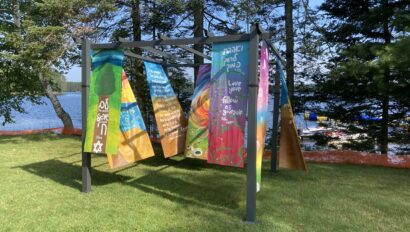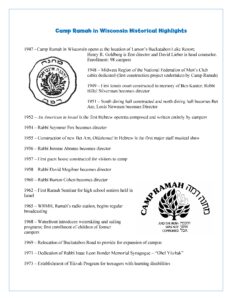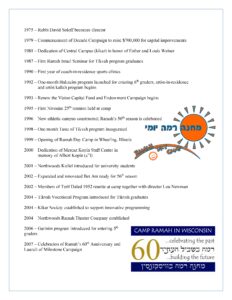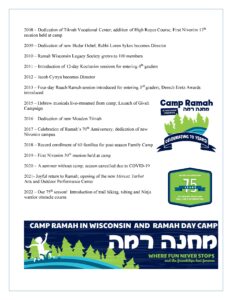Reflections on Parashat Terumahby Adina Allen, Assistant Director
For many of our campers, their time at camp nourishes their souls for the rest of the year. For our small team of dedicated professionals who work year-round for camp, our work during “the offseason” makes camp happen. The meetings, phone calls, interviews, and planning for the program itself are components that we focus on in our Chicago office. But we have another team, one that usually gets far less attention and that even our diehard fans may not even know about, who work throughout the entire winter: our construction, site, and maintenance staff. Five days a week from mid-August through early June, they are on site in Conover caring for, repairing, and enhancing the beautiful infrastructure of Camp Ramah in Wisconsin.
The planning process and level of detail is no surprise to those following this week’s Torah portion. In parashat Terumah we receive a very detailed description for building the Mishkan, a portable sanctuary in the desert, ranging from materials to dimensions down to the smallest component.
Before commanding B’nai Yisrael (the Israelites) to build the Mishkan, the Torah states ועשו לי מקדש, ושכנתי בתוכם, v’asu li mikdash, v’shachanti b’tocham, “and let them make Me a sanctuary, that I may dwell among them” (Exodus 25:8). Famously, readers of the Bible throughout the centuries have asked themselves: If God is asking B’nai Yisrael to build a physical structure, should not the Torah state, “and I will dwell inside of it [the Mishkan]”, not “among them [B’nai Yisrael]”? To understand one possible reason for the peculiar language chosen by the Torah, we have to look at the very beginning of the instruction manual that makes up our parashah. As soon as B’nai Yisrael are instructed to build the Mishkan, the Torah states: כל איש אשר ידבנו לבו, תקחו את תרומתי, kol is hasher yid’venu libo, tik’chu et t’rumati, “from every person whose heart inspires him to generosity, you shall take My offering” (Ex: 25:2). The Mishkan, though spectacular in its design, is inherently just a building. Only when each member of B’nai Yisrael brings a voluntary individual contribution to the broader project is the Mishkan truly finished. That final measure of accomplishment is when God’s presence, the Shechinah, dwells within it, and the Mishkan truly becomes a Holy Space.
Right now, in snow-covered Conover, our maintenance staff is in the process of renovating and reconstructing our Moadon Tikvah. This building has been the central meeting place of our Tikvah special-need program for over three decades. (In fact, the building was originally constructed by the talented George Merkel, who was hired shortly thereafter as our Maintenance Supervisor and, though he stepped down from that role a number of years ago, remains a beloved and valuable member of our maintenance staff and Ramah team as Senior Maintenance Supervisor!) In addition to requiring general updating and renovation after thirty-plus years of use, our Tikvah program has also grown significantly over the years. Our Conover staff began working on this construction immediately following camp in August. The detailed work of the crew, designed by our architect and Ramah alumnus George Sarfatty and implemented by Tom Merkel, our Maintenance Supervisor, (faintly but importantly) resonates the attention given by B’nai Yisrael to the construction of the Mishkan. The building has been expanded nearly 40% including expanded office, bathroom, and kitchen space; a redesigned and expanded central meeting space; and a new meeting room and sensory room.
The final touches that our dedicated team of builders will put on the Moadon Tikvah in the next few months, working through the cold winter with an amazing dedication to their work, lay the foundation for great excitement for this summer and many summers to come. The hard work put into these buildings by our construction team comes alive during the first days of camp when they are filled with the sounds of laughter and singing, with the presence of children making real friendships and connections. At Ramah we are only able to experience the presence of the Divine when all of our contributions are valued, when each of us feels that we can fully bring the inspired gifts which are ours to contribute. Reading parashat Terumah in the midst of winter, we are reminded of an important lesson that we teach each and every summer at Camp Ramah. Only when each of us finds that our contributions are equally valued, when each of us experiences a camp that celebrates us for who we truly are, are we building a place where God’s presence dwells—not within camp but amongst all of us who fill the camp with our presence.
It is when we fill up camp and bring ourselves and our contributions to this space that we see the divine nature of Camp Ramah in Wisconsin truly unfold.
Shabbat Shalom!






